
The Chromodorididae, or chromodorids, are a taxonomic family of colourful, sea slugs; dorid nudibranchs, marine gastropod mollusks in the superfamily Doridoidea. “Chromodorid nudibranchs are among the most gorgeously coloured of all animals.” The over 360 described species are primarily found in tropical and subtropical waters, as members of coral reef communities, specifically associated with their sponge prey. The chromodorids are the most speciose family of opisthobranchs. They range in size from <10mm to over 30 cm, although most species are approximately 15–30 mm in size.

Elysia is a genus of sea slugs, marine gastropod molluscs in the family Plakobranchidae. These animals are colorful sea slugs, and they can superficially resemble nudibranchs, but are not very closely related to them. Instead they are sacoglossans, commonly known as sap-sucking slugs.
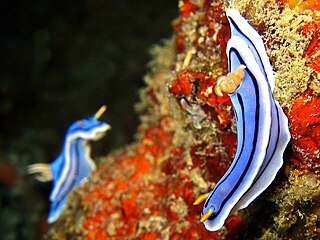
Chromodoris is a genus of very colourful sea slugs or dorid nudibranchs, marine gastropod molluscs, and the type genus of in the family Chromodorididae. Within the genus Chromodoris, there are currently 101 classified species. Species within Chromodoris are commonly found in tropical and subtropical waters, living as members of reef communities and preying primarily on sponges. A molecular phylogeny of the family Chromodorididae resulted in this genus being restricted to a smaller number of species than formerly, most of which have longitudinal black lines on the mantle. Many former members of Chromodoris were transferred to Goniobranchus
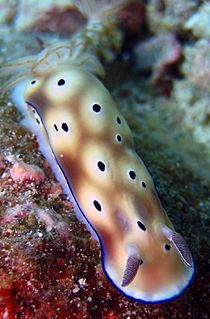
Hypselodoris tryoni is a species of sea slug, a dorid nudibranch, a marine gastropod mollusk in the family Chromodorididae.
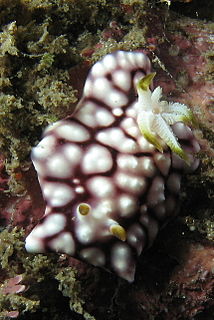
Goniobranchus geometricus is a species of colourful sea slug, a dorid nudibranch, a marine gastropod mollusc in the family Chromodorididae.

Nembrotha purpureolineata is a species of colourful sea slug, a dorid nudibranch, a marine gastropod mollusc in the family Polyceridae. Nembrotha rutilans, classified as a separate species until 2008, has now been reclassified as Nembrotha purpureolineata.

Chromodoris strigata, commonly known as the streaked chromodoris, is a species of colourful sea slug, a dorid nudibranch, a marine gastropod mollusc in the family Chromodorididae.
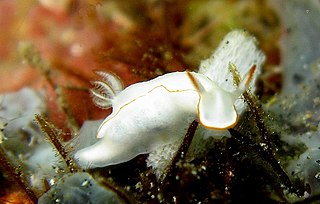
Thorunna is a genus of sea slugs, dorid nudibranchs, shell-less marine gastropod mollusks in the family Chromodorididae.

Hypselodoris pulchella is a species of sea slug, a dorid nudibranch, a marine gastropod mollusk in the family Chromodorididae.

Hypselodoris maridadilus is a species of colourful sea slug or dorid nudibranch, a marine gastropod mollusk in the family Chromodorididae. It feeds on sponges.

Hypselodoris nigrostriata is a species of sea slug or dorid nudibranch, a marine gastropod mollusk in the family Chromodorididae.

Hypselodoris kaname is a species of sea slug or dorid nudibranch, a marine gastropod mollusk in the family Chromodorididae.

Hypselodoris emma is a species of sea slug or dorid nudibranch, a marine gastropod mollusk in the family Chromodorididae.

Hypselodoris maculosa is a species of sea slug or dorid nudibranch, a marine gastropod mollusk in the family Chromodorididae.
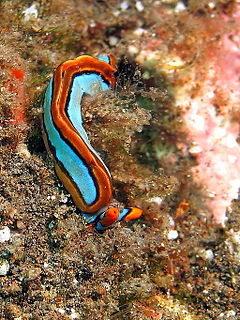
Thuridilla lineolata is a species of sea slug, a sacoglossan, a marine gastropod mollusk in the family Plakobranchidae. It is an Indo-Pacific species that lives in or near coral reefs and eats algae.

Thuridilla gracilis is a species of sea slug, a sacoglossan, a marine gastropod mollusk in the family Plakobranchidae. It is an Indo-Pacific species that lives in or near coral reefs and eats algae.
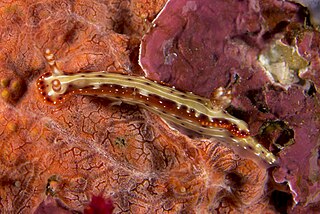
Hypselodoris decorata is a species of sea slug or dorid nudibranch, a marine gastropod mollusk in the family Chromodorididae.

Philinopsis speciosa, the blue-lined philinopsis, is a species of sea slug, a shell-less opisthobranch gastropod mollusc in the family Aglajidae. It is native to the Indo-Pacific region.

Tubulophilinopsis gardineri, the Gardiner’s philinopsis, or Gardiner's headshield slug is a species of sea slug, a shell-less opisthobranch gastropod mollusc in the family Aglajidae. It is native to the Indo-Pacific region.

Thuridilla moebii is a species of sacoglossan sea slug, a shell-less marine opisthobranch gastropod mollusc in the family Plakobranchidae. It is found in shallow water in the tropical west and central Indo-Pacific region.




















